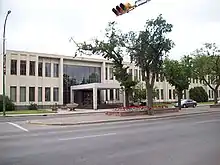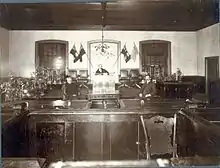Court of King's Bench for Saskatchewan
The Court of King's Bench for Saskatchewan (Court of Queen's Bench for Saskatchewan during the reign of female monarchs) is the superior trial court for the Canadian province of Saskatchewan.
| Court of King's Bench for Saskatchewan | |
|---|---|
| Location | Battleford; Estevan; Melfort; Moose Jaw; Prince Albert; Regina; Saskatoon; Swift Current; Weyburn; and Yorkton |
| Authorized by | The Queen's Bench Act, 1998 |
| Number of positions | 33 |
| Website | Court of King's Bench |
| Chief Justice | |
| Currently | Martel D. Popescul[1] |
| Since | January 1, 2012 |
Structure and organization

The Court consists of 29 full-time judges[2] and 10 supernumerary judges, all appointed and paid by the federal government.[3][4] The court's Chief Justice, currently the Honourable Martel D. Popescul, is styled the Chief Justice of the King's Bench. Both the Chief Justice and puisne justices are addressed as "My Lord" or "My Lady" and referred to as "His Lordship" or "Her Ladyship". This differs from the terminology used in the Provincial Court of Saskatchewan, whose judges are "Your Honour", "His Honour" or "Her Honour".
The Court sits in nine judicial centres[5][6][7] and actions are generally brought in the judicial centre closest to where the action arose, or the residence or place of business of the defendant.[8]
Jurisdiction
The Court hears civil and criminal law cases. It is a court of inherent jurisdiction and there is no monetary limit on the claims which it may hear. It also has original jurisdiction over matters assigned to it by statute, such as adjudicating human rights complaints.
The court has a Family Law Division, which has exclusive jurisdiction over family law matters in the judicial centres of Saskatoon, Regina, and Prince Albert, and concurrent jurisdiction (with the Provincial Court) over family law matters in all other areas of the province.[9][10]
As a superior court of original jurisdiction, it has supervisory jurisdiction over administrative tribunals, exercised by the prerogative writs. It also has some appellate jurisdiction, hearing appeals from the Provincial Court of Saskatchewan and some administrative bodies. Appeals may be taken from the King's Bench to the Court of Appeal for Saskatchewan. A further appeal lies to the Supreme Court of Canada.
History

Until it became a province in 1905, Saskatchewan was part of the North-West Territories as it existed at that time and its judicial system was that of the territory. In fact, it was not until 1907 – two years after Saskatchewan became a province – that the new province's judicial system was established.[11] The initial court structure of 1907 consisted of three courts: the Supreme Court of Saskatchewan, the District Court (similar to the County Courts of other provinces) and the Surrogate Court. There was no appeal court; rather, appeals were conducted by the full court of the Supreme Court of Saskatchewan, consisting of all the judges of the Supreme Court, other than the judge who made the decision under appeal.

During the First World War, the province reorganized its courts. In 1915, the province passed legislation, The King's Bench Act[12] and The Court of Appeal Act,[13] for the purpose of creating a new court structure. Those acts came into effect on March 1, 1918, resulting in the abolition of the Supreme Court of Saskatchewan and the creation of the trial-level Court of King's Bench and the Court of Appeal.[14][15]
In 1981, Saskatchewan merged its District Court into the Court of Queen's Bench.[16] As part of that process, the judicial centres of the District Court became the judicial centres of the Court of King's Bench.
Styling
The Court of King's Bench Act foresaw the need to rename the Court in the event of a female monarch. The Act provides that, during the reign of a Queen, the Court is known as the Court of Queen's Bench for Saskatchewan. Should the monarchy be vested in a King, it will be known as the Court of King's Bench for Saskatchewan.[14]
Courts of Saskatchewan
There are three main courts in Saskatchewan:
- Court of Appeal for Saskatchewan – appellate court; highest court of Saskatchewan.
- Court of King's Bench for Saskatchewan – superior trial court of Saskatchewan with inherent and unlimited jurisdiction
- Provincial Court of Saskatchewan – court of first instance; trial court with jurisdiction defined by statute
Notable cases
Attorney General of Canada v Merchant Law Group, 2015
In January 2015, the Attorney General of Canada, on behalf of the federal government launched a law suit against Tony Merchant's Regina, Saskatchewan-based law firm—Merchant Law Group (MLG).[17][18][19]
July 16, 2015 IRSSA ruling by Justice Neil Gabrielson
Under then Prime Minister Stephen Harper, the Conservative government gave a mandate to officials from the Department of Aboriginal Affairs and Northern Development—now known as the Crown-Indigenous Relations and Northern Development Canada—to "negotiate a settlement with the Catholic entities" who had committed in the Indian Residential Schools Settlement Agreement (IRSSA) to raise $25 million to pay for healing programs for survivors.[18] As a result, in August 2015, "negotiations began, resulting in a signed agreement on October 30, 2015, and a withdrawal of the Protective Notice of Appeal.[20] Justice Neil Gabrielson had ruled on July 16, 2015 that the federal Conservative government under then Prime Minister Stephen Harper had "inadvertently released 50 Catholic entities from their contractual responsibility to try to raise up to $25-million for aboriginal healing programs".[20] He said that lawyers on both sides—Alexander Gay representing the federal government and Gordon Kuski, representing the "Catholic entities" had a "meeting of the minds" on a "re-lease" of the Catholic entities from "all obligations". Justice Gabrielson ruled that Mr. Gay "should be presumed in this dispute to have had the authority to negotiate on behalf of the Canadian government".[20]
A federal government official had confirmed there was "miscommunication with government lawyers that allowed the Catholic Church to escape paying close to $25-million", according to a May 19, 2016 Aboriginal Peoples Television Network (APTN) article "Residential schools settlement agreement under fire".[18]
Under the Indian Residential Schools Settlement Agreement (IRSSA) fifty Catholic entities were under three obligations which included $29-million to the Aboriginal Healing Foundation, $25-million through "services to aboriginal communities" and finally to use their "best efforts" to "raise $25-million for additional healing programs". By 2015, only $3.7 of the $25 million had been raised. In his July ruling, Justice Gabrielson said that "for a payment of $1.2-million, the Catholic entities were to be released from their responsibilities to raise the remainder of the $25-million, and be seen to have completed the other two categories of contributions."[20] The Catholic entitles had also claimed $29 million for administrative costs.[20]
At the request of the Globe and Mail a University of Alberta law professor, Eric Adams, and Ken Young, a residential school survivor and a Winnipeg lawyer, who read Justice Gabrielson's ruling said that the government under Prime Minister Justin Trudeau should have appealed Gabrielson's ruling, as the stakes were so high.[20] Young said that it did not appear that Mr. Gay had agreed on behalf of the federal government to "allow the Catholic entities to walk away from their fundraising obligations." The decision served the federal government’s interests which explains why an appeal of the ruling was never sought. The Catholic entities under the IRSSA were allowed create a corporation that was to be used to make payment. The fifty Catholic entities were allowed to hide behind a secret agreement where the identity of the Catholic entities that made or failed to make a contribution to the corporation was to remain undisclosed. The victims received payment from the corporation without ever knowing the providence of the monies. The in-kind contributions as well as the monetary contributions were never fully paid. The federal government was content to allow Justice Gabrielson’s ruling to stand and bring an end to what was a bad deal for the victims.
In April 2016, then Indigenous Affairs Minister Carolyn Bennett said that while the Liberal government under Prime Minister Trudeau would put pressure on the Catholic church to resume fundraising efforts towards to remainder of the $25 million, the federal government would not "make up the shortfall."[20]
Crown vs Stanley (2018)
In the Crown vs Stanley, presided by Saskatchewan Chief Justice Popescul, an all-white jury[21] acquitted local Battleford, Saskatchewan farmer Gerald Stanley on February 9, 2018. The jury found that the death of Colten Boushie, from the Cree Red Pheasant First Nation[22] occurred because of "hang fire".[23][24] Clint Wuttunee, Chief of the Red Pheasant First Nation, called the verdict "absolutely perverse".[21][25][23] Following the announcement of the acquittal, rallies and vigils took place across Canada.[26] The rally at the Saskatoon court attracted 1,000 people who supported Boushie's family and were frustrated by the jury's decision.[26] At a press conference on February 11, hosted by Saskatoon Tribal Council, Mayor Clark described the event as a "defining moment for this community and this country".[26]
References
- "Saskatchewan Law Courts - Judges". sasklawcourts.ca. Archived from the original on 2018-08-21. Retrieved 2018-08-20.
- "Number of federally appointed judges as of July 1, 2018", Office of the Commissioner for Federal Judicial Affairs Canada, retrieved September 27, 2020
- Courts of Saskatchewan website: Court of Queen's Bench Judges.
- Peter Hogg, Constitutional Law of Canada, 2nd ed. (Toronto: Carswell, 1985), pp.136–137.
- Courts of Saskatchewan website: Court of Queen's Bench Locations.
- The Queen's Bench Act, 1998, S.S. 1998, c. Q-1.01, s. 21.
- The Queen's Bench Regulations, R.R.S. c. Q-1.01 Reg 1, s. 3.
- The Queen's Bench Act, 1998, S.S. 1998, c. Q-1.01, s. 22(1).
- Courts of Saskatchewan website: Court of Queen's Bench Family Law.
- The Queen's Bench Regulations, R.R.S. c. Q-1.01 Reg. 1, s. 8.
- Saskatchewan Act, S.C. 1905, c. 42, s. 16.
- The King's Bench Act, S.S. 1915, c. 10.
- The Court of Appeal Act, S.S. 1915, c. 9.
- Courts of Saskatchewan website Queen's Bench History. Retrieved 12 March 2012.
- Courts of Saskatchewan website Court of Appeal History. Retrieved 12 March 2012.
- Saskatchewan Archives Board, Court Records
- Pacholik, Barb (January 25, 2016). "Regina lawyer Tony Merchant calls multi-million-dollar win 'wonderful'". Regina Leader Post. Retrieved September 26, 2020.
- Barnsley, Paul; Martens, Kathleen (May 19, 2016). "Residential schools settlement agreement under fire". APTN News. Sioux Lookout, Ontario. Retrieved September 26, 2020.
- Attorney General of Canada v Merchant Law Group, 2016 SKQB 25
- Fine, Sean; Galloway, Gloria (April 20, 2016). "Federal government killed appeal of residential-school settlement ruling". The Globe and Mail. Toronto And Ottawa. Retrieved September 27, 2020.
- Graveland, Bill (February 10, 2018). "Not guilty verdict in shooting death of Colten Boushie 'absolutely perverse'". The Toronto Star. Retrieved February 11, 2018.
- "Gerald Stanley acquitted of all charges in the death of Colten Boushie". APTN National News. February 10, 2018. Retrieved February 11, 2018.
- Plaxton, Michael (February 11, 2018). "The Stanley verdict: Manslaughter and 'hang fire'". The Globe and Mail. Battleford, Saskatchewan. Retrieved February 11, 2018.
- Friesen, Joe (February 8, 2018). "Gerald Stanley must be held accountable for death of Colten Boushie, Crown argues". The Globe and Mail. Battleford, Saskatchewan. Archived from the original on May 21, 2022. Retrieved February 11, 2018.
- Graveland, Bill (February 8, 2018). "Defence claims no evidence Gerald Stanley intentionally killed Colten Boushie". The Toronto Star. Retrieved February 11, 2018.
- Frieson, Joe (February 10, 2018). "Thousands rally across Canada after Gerald Stanley acquitted in killing of Colten Boushie". The Globe and Mail. Saskatoon, Saskatchewan. Retrieved February 11, 2018.